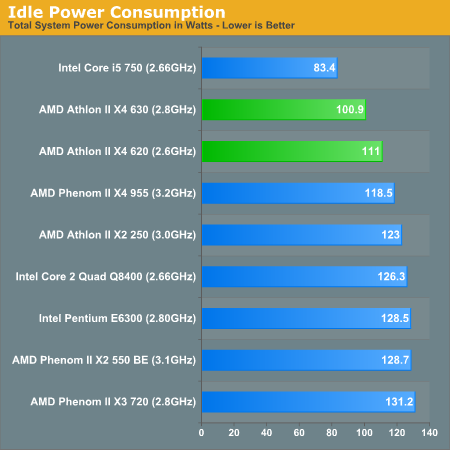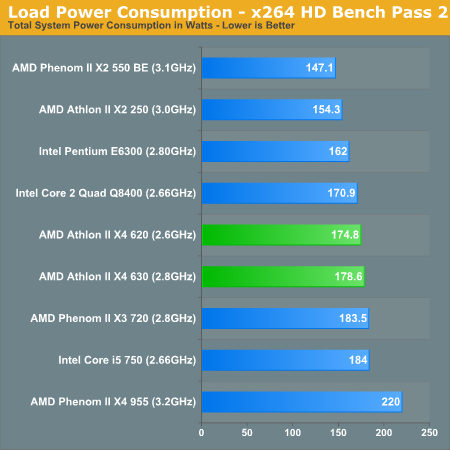AMD Athlon II X4 620 & 630: The First $99 Quad Core CPU
by Anand Lal Shimpi on September 16, 2009 12:00 AM EST- Posted in
- CPUs
Power Consumption

Without power gating the Athlon II X4 draws as little power as possible, noticeably less than any of AMD's other multi-core CPUs. Our X4 620 sample was a bit more power hungry than our 630.

Even under load the power consumption story is a good one. Given the position of our Q8400 sample here we'd say that the Q8200 would probably use a bit less power, but the price differential should more than make up for it.
Overclocking
As I mentioned at the start of this article I managed to hit 3.25GHz on the Athlon II X4 620 without any additional voltage using the retail AMD cooler:

I could hit 260MHz x 13.0 for 3.38GHz by upping the voltage, but the gain wasn't worth the additional power usage. Anything higher wasn't possible without more exotic cooling or much more voltage. The performance improved handily at 3.25GHz:
| Processor | Adobe Photoshop CS4 | x264 2nd pass | Left 4 Dead |
| AMD Athlon II X4 620 (2.6GHz) | 27.5 seconds | 15.4 fps | 93.2 fps |
| AMD Athlon II X4 620 @ 3.25GHz | 23.2 seconds | 18.9 fps | 102.9 fps |
| AMD Phenom II X4 955 (3.2GHz) | 22.3 seconds | 19.1 fps | 121.4 fps |
| Intel Core 2 Quad Q8400 | 21.8 seconds | 17.9 fps | 105.6 fps |
At 3.25GHz the Athlon II X4 ends up faster than the even more expensive Q8400in some cases, and gets much closer in others. In applications where the large L3 cache isn't missed, the overclocked Athlon II can end up being a poor man's Phenom II X4 955. But looking at the Left 4 Dead performance, there's no such thing as a free lunch - the overclocked Athlon II isn't quite that good.










150 Comments
View All Comments
Exar3342 - Wednesday, September 16, 2009 - link
$50 is pretty trvial in the overall cost of the computer. Even a relatively cheap system with a O/S and a acceptable graphics card would be $400-500. This difference is only ~%10 of the overall cost, and yields a performance increase of 20-40% and is more efficient.You are thinking small, think bigger.
With the Athlon X4 at $100 and the i5/i7 at $150-250, there is really no reason for anyone to buy a brand-new PhII system at all. If you want cheap, get the Athlon X$; if you want fast, get the i5/i7.
Patrick Wolf - Wednesday, September 16, 2009 - link
"With the Athlon X4 at $100 and the i5/i7 at $150-250, there is really no reason for anyone to buy a brand-new PhII system at all."You are thinking big, think smarter. And the i5 is $200, not $150.
The price per performance scales linearly. An Athlon X4 w/ mobo and DDR2 < PhenomII X4 w/ mobo and DDR2 < i5/i7 w/ mobo and DDR3.
You get what you pay for.
And less we forget, DDR3 isn't exactly cheap yet. And the new 1156 boards are starting at ~$100.
lopri - Wednesday, September 16, 2009 - link
To all those who worry about AMD's finance: Why do you care?It has been a great mystery to me throughout many years. Sure I understand the need for competition which benefits everyone in a free market, but there are other things that can ensure fair competition. Worrying about a corporation's profit margin is not the first on the list. I'd leave that to the management and shareholders.
Smidge - Thursday, September 17, 2009 - link
Competition is important, both for driving prices down, and driving development. As I recall, Intel started their whole tick-tock releases of architectures in response to starting to lose the lead in the processor market. As well as that they were reportedly sitting on a bunch of tech advances until they'd sold enough of their previous gen stuff. The cost savings are especially obvious when you think of how prices tend get slashed whenever the competition releases a new product, especially if it outperforms products in a higher price bracket.Now remember that AMD are the only real competition in both the CPU (x86_64) and graphics markets for Intel and Nvidia respectively. Both markets have an extremely high barrier to entry. Well, with the requirement of probably billions in startup investment and decades of processor research, it's more like a nigh-impenetrable barrier to entry. So if AMD were to go under, Intel and Nvidia would both have monopolies in their respective markets for a long time to come.
I think it's perfectly fair to worry about AMD's finances given how much it would suck for us consumers if they were to go under (as they were close to doing before the globalfoundries spinoff). As I would worry if Intel or Nvidia were struggling. Though Intel seem to be sitting on a boatload of cash so that's not much of an issue.
BSMonitor - Wednesday, September 16, 2009 - link
Just noticed on the benchies that the Athlon II at 2.8GHz was pretty close to the Phenom II at 3.2GHz... If you compared the two at the same clock, what does the 6MB L3 get one across the board?? In a lot of cases, seemed to be very little. Just one of those charts with percentages side by side would be cool!strikeback03 - Wednesday, September 16, 2009 - link
That chart is in the middle of the first page - a breakdown of the SysMark results at 2.8GHz.BSMonitor - Wednesday, September 16, 2009 - link
Right, that's just SysMark.. Sometimes he has a chart from top to bottom with all the benchmarks..fitten - Wednesday, September 16, 2009 - link
In the Cinebench R10 section:"the Q8200 is the slowest chip here." when it is clearly in the middle of the pack. I think it should be "the Q8200 is the slowest quad core chip here."
fitten - Wednesday, September 16, 2009 - link
My bad... that is talking about the single-threaded performance, not the multithreaded performance.DrMrLordX - Wednesday, September 16, 2009 - link
I'm curious about the NB overclocking on these chips. Few have been able to achieve stable NB speeds over about 2.6 ghz on Phenom IIs. How far could you push the NB on your 630? Or 620, for that matter?